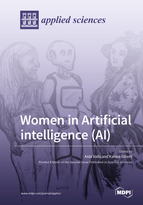Women in Artificial intelligence (AI)
A special issue of Applied Sciences (ISSN 2076-3417). This special issue belongs to the section "Computing and Artificial Intelligence".
Deadline for manuscript submissions: closed (15 December 2021) | Viewed by 50253
Special Issue Editors
Interests: decision support systems, aggregation operators, management of linguistic and semantic data, models of uncertainty, machine learning and deep learning
Interests: big data; statistics; artificial intelligence; machine learning
Special Issues, Collections and Topics in MDPI journals
Special Issue Information
Dear Colleagues,
Gender equality is one of the objectives of the ONU Agenda 2030. In the areas denominated STEM (Science, Technology, Engineering, and Mathematics), the bias of gender is particularly exaggerated. The number of male researchers working in STEM is much larger than for women, and this is a constant in countries all over the world, from Europe to USA. This imbalance affects the visibility of the work done by women, which is difficult to find among a large number of male names. In the field of Artificial Intelligence, this male bias influences the way intelligent systems are developed, designed, and conceived. This may have a large impact on the future world, where digital transformation seems to be connected to the new Artificial Intelligence developments.
This Special Issue aims to gather research work done by women in a single journal issue in order to enhance the visibility. This may also contribute to greater dissemination of the exceptional research being done by female scientists.
Because of the relevance of Artificial Intelligence nowadays, this Special Issue is focused on research conducted in the field of Artificial Intelligence, which is a STEM discipline that has increased in interest and applicability in recent years. Thus, this Special Issue will provide an attractive compendium of the AI research led by women over a wide perspective, with focus on real social or industrial applications to health, mobility, or any other topic relevant for digital society development, and new theoretical contributions to all branches of the AI field, from reasoning to image processing, welcoming voice, natural language processing, and social AI, among others.
The two Guest Editors are women involved in gender equality initiatives in Catalonia (Spain). Dr. Karina Gibert is President of the working group donesIAcat (women in AI in Catalonia) in the Catalan Association for Artificial Intelligence (a chapter of the EurAI association). Dr. Aida Valls is Chair of donesIAcat in the region of Tarragona (south Catalonia). Both have a long trajectory of research in AI and working to bridge the gender gap in Artificial Intelligence as well as Informatics Engineering more generally. Hence, we are pleased to serve as Guest Editors of this Special Issue focused on the AI field. The goal is to highlight the women working on cutting edge topics in AI, both from a theoretical and applied point of view.
We encourage women scientists leading research on AI to submit an original manuscript to this Special Issue. Submissions must have a woman as first author to be considered for inclusion.
Dr. Aida Valls
Prof. Dr. Karina Gibert
Guest Editors
Manuscript Submission Information
Manuscripts should be submitted online at www.mdpi.com by registering and logging in to this website. Once you are registered, click here to go to the submission form. Manuscripts can be submitted until the deadline. All submissions that pass pre-check are peer-reviewed. Accepted papers will be published continuously in the journal (as soon as accepted) and will be listed together on the special issue website. Research articles, review articles as well as short communications are invited. For planned papers, a title and short abstract (about 100 words) can be sent to the Editorial Office for announcement on this website.
Submitted manuscripts should not have been published previously, nor be under consideration for publication elsewhere (except conference proceedings papers). All manuscripts are thoroughly refereed through a single-blind peer-review process. A guide for authors and other relevant information for submission of manuscripts is available on the Instructions for Authors page. Applied Sciences is an international peer-reviewed open access semimonthly journal published by MDPI.
Please visit the Instructions for Authors page before submitting a manuscript. The Article Processing Charge (APC) for publication in this open access journal is 2400 CHF (Swiss Francs). Submitted papers should be well formatted and use good English. Authors may use MDPI's English editing service prior to publication or during author revisions.







